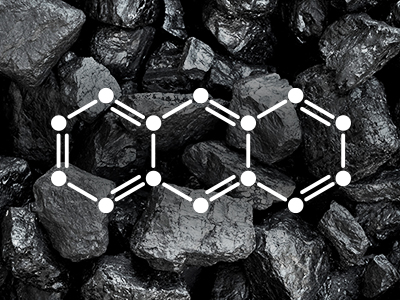The first known use of the word aromatic as a chemical term to apply to compounds that contain a phenyl group occurs in an article in 1855 by August Wilhelm von Hofmann, a German Chemist who made considerable contributions to organic chemistry. Hofmann used the term for a class of benzene compounds, many of which have odors (aromas), unlike pure saturated hydrocarbons. Benzene (C6H6) is the least complex aromatic hydrocarbon and was the first one named as such. The nature of its bonding was first recognized in the 19th century by August Kekulé, the principal founder of the theory of chemical structure and the Kekulé structure of benzene.
What are PAHs
PAHs are organic substances made up of carbon and hydrogen atoms grouped into at least two condensed or fused aromatic ring structures or organic compounds that are composed of multiple aromatic rings. The key difference between polycyclic and polynuclear aromatic hydrocarbons is that the term polycyclic describes the presence of two or more cyclic structures fused to each other, whereas the term polynuclear describes the presence of more than one atom.

PAHs are a chemical class that occurs naturally in coal, crude oil, and gasoline. They result from burning coal, oil, gas, wood, garbage, and tobacco (cigarette smoke contains many PAHs). They are also produced by the incomplete combustion of organic matter for example, in engines and incinerators or when biomass burns in forest fires.
The simplest representative of PAH is naphthalene, having two aromatic rings. Examples of three-ring compounds are anthracene and phenanthrene. More than 20% of the carbon in the universe may be associated with PAHs which are considered possible starting material for the earliest forms of life.
PAHs also belong to the class of chemicals known as persistent organic pollutants (POPs).
List of PAHs
Some popular PAH compounds, their common name, and their characteristics are:
- Naphthalene – Camphor.
- Anthracene – Coal tar, used in dyes such as the red dye alizarin.
- Phenanthrene – Used to make dyes, plastics, pesticides, explosives, and drugs.
- Acenaphthylene – Colorless crystalline solid used in dye synthesis, insecticides, fungicides, and in the manufacture of plastics.
- Fluorene – Forms white crystals that exhibit a characteristic, aromatic odor like that of naphthalene. Combustible and has violet fluorescence. Obtained from coal tar for commercial purposes, used to make dyes, plastics, and pesticides.
- Fluoranthene – is released naturally during the burning of fossil fuels and wood and it is an ingredient in dyes, pharmaceuticals, and insulating oils.
- Pyrene – Commercial name of a fire extinguisher CCl4. It is the only organic compound that is non-inflammable.
- Benz[a]anthracene – Produced by incomplete combustion of organic matter. Not produced commercially but is used in research laboratories.
- Chrysene – Ortho-fused polycyclic arene found commonly in the coal tar pitch, creosote, or other coal tar products.
- Benzo[b]fluoranthene – Colorless, aromatic hydrocarbon consisting of five fused rings and formed by the incomplete burning of organic matter. Primarily found in gasoline exhaust, tobacco and cigarette smoke, coal tar, soot, amino acids, and fatty acid pyrolysis products.
Classification of PAHs
PAHs with up to six fused aromatic rings are known as ‘small’ PAHs, whereas those containing more than six aromatic rings are called ‘large’ PAHs. They are also classified into alternate and non-alternate compounds.
PAHs are classified into light-molecular-weight (LMW) PAHs having two or three aromatic rings and high-molecular-weight (HMW) PAHs having four or more aromatic rings.
Sources of PAHs in the Environment
PAHs enter the environment through both natural and manmade processes. The principal natural sources of environmental PAH are forest fires and volcanic activity. Burning of wood for heating and cooking has always been a significant manmade source of atmospheric PAH. Since the Industrial Revolution, there have been important stationary sources, such as manufacturing and power generation. Since the early 20th century, mobile sources in the form of gasoline and diesel-fueled engines also became important contributors to total environmental PAHs.
Municipal incinerators are a troublesome source of PAH emissions, in part because it is difficult for municipal authorities to exercise stringent control over the content and composition of the garbage. PAH measured in fly ash from municipal waste incinerators usually includes phenanthrene, benzo(g,h,i)perylene, fluoranthene, benzo(a)fluoranthene, indeno(1,2,3-c,d)pyrene, and chrysene.
Several manufacturing activities have been responsible for large environmental emissions. Coal tars are byproducts of destructive distillation (carbonization) of coal to produce coke or gas and may contain hundreds to thousands of individually identifiable chemicals. Automotive exhaust from cars and trucks is also a major contributor to atmospheric PAH, particularly in urban environments.
Common Products that use PAH
Foods that may contain low levels of PAHs include roasted coffee, roasted peanuts, refined vegetable oil, grains, vegetables, and fruits. High levels of PAHs are known from dried fruits, olive pomace oil, smoked fish, grape seed oil, smoked meat products, fresh molluscs, spices, sauces, and spice mixtures. A variety of cosmetics and shampoos are made with coal tar and therefore contain PAHs. The PAH compound naphthalene is present in some mothballs.
Impacts on Human Health
The effect of PAHs on human health depends mostly on the duration and route of exposure, the volume or concentration of PAHs to which one is exposed, and the relative toxicity of PAHs. Humans can consume PAHs via different routes, such as inhalation, dermal touch, and ingestion. Many PAHs are widely referred to as carcinogens, mutagens, and teratogens and thus pose a significant danger to human health and the well-being of humans.
Although PAHs generally have a low degree of acute toxicity to humans, increased incidences of lung, skin, and bladder cancers are associated with occupational exposure to PAHs. Repeated skin contact with the PAH naphthalene can result in redness and inflammation of the skin. Other compounds commonly found with PAHs may cause short-term symptoms such as eye irritation, nausea, vomiting, diarrhea, and confusion.
Long-term health effects of exposure to PAHs may include cataracts, kidney and liver damage, and jaundice. Breathing or swallowing large amounts of naphthalene can cause the breakdown of red blood cells. Skin, lung, pancreas, esophagus, bladder, colon, and female breast are numerous organs prone to tumor development due to long-term PAH exposure. PAH exposure may increase the risk of lung cancer as well as cardiovascular disease, including atherosclerosis, thrombosis, hypertension, and myocardial infarction.
Impacts on Animals
Long-term exposure to low levels of certain PAHs like Benzo(a)pyrene has caused cancer in laboratory animals. Although animal studies have shown adverse reproductive and developmental effects from PAH exposure, these effects have generally not been seen in humans.
PAHs are highly lipid soluble and thus readily absorbed from the gastrointestinal tract of mammals. They are absorbed through ingestion, inhalation, and dermal contact, according to animal study data. The toxicity of PAHs to aquatic species is affected by metabolism and photooxidation. They are generally harmful in the presence of ultraviolet light. PAHs have moderate to high acute toxicity to aquatic organisms and birds. Researchers have reported increased incidences of skin, lung, bladder, liver, and stomach cancers and injection-site sarcomas in animals.
Conclusion
PAHs, with their potential to cause cancer, mutagenicity, and other adverse health effects, demand regulatory intervention. The widespread use of these compounds in various industries necessitates a structured approach to mitigate their risks. Governments and regulatory bodies are focusing on setting standards to protect human health and the environment.
In our next article, we will look at what these institutions are doing to craft responsible regulation of these substances.




